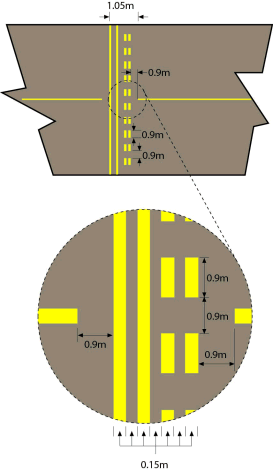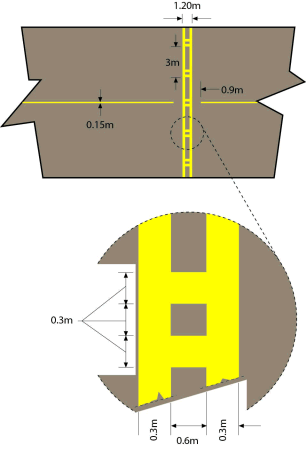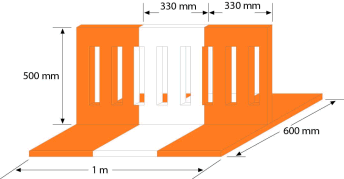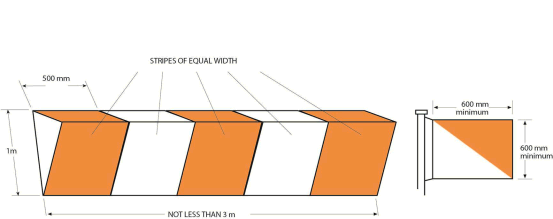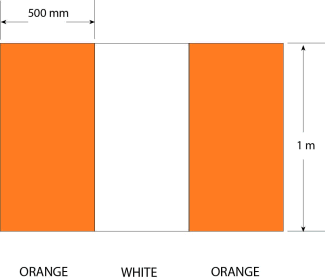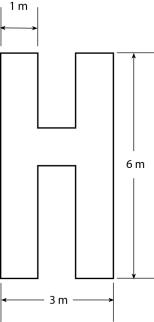- Latest available (Revised)
- Original (As made)
The Rules of the Air Regulations 2015
You are here:
More Resources
Status:
This is the original version (as it was originally made). This item of legislation is currently only available in its original format.
SECTION 5AERODROME VISUAL SIGNALS AND MARKINGS
Aerodrome Visual Signals and Markings
17. Within the United Kingdom any signal or marking which is specified in these Rules and which is given or displayed—
(a)by any person in an aircraft;
(b)at an aerodrome; or
(c)at any other place which is being used by aircraft for landing or take-off,
has the meaning assigned to it by this section.
Misuse of signals and markings
18. A person in an aircraft or on an aerodrome or at any place at which an aircraft is taking off or landing must not—
(a)make any signal which may be confused with a signal specified in SERA.3301 and Appendix 1 to SERA; or
(b)except with lawful authority, make any signal which the person knows or ought reasonably to know to be a signal in use for signalling to or from any of Her Majesty’s naval, military or air force aircraft.
Markings for paved runways and taxiways
19.—(1) Subject to paragraph (2), two yellow broken lines and two yellow continuous lines, as illustrated in the diagrams in this paragraph—
signify the designated visual holding position associated with a runway beyond which no part of a flying machine or vehicle must project in the direction of the runway without permission from the air traffic control unit at the aerodrome during the notified hours of watch of that unit.
(2) Outside the notified hours of watch of that unit or where there is no air traffic control unit at the aerodrome the markings referred to in paragraph (1) signify the position closest to the runway beyond which no part of a flying machine or vehicle must project in the direction of the runway when the flying machine or vehicle is required to give way to aircraft which are taking off from or landing on that runway.
(3) Subject to paragraph (4), a marking, consisting of two yellow, parallel perpendicular lines intersected by horizontal yellow lines, as illustrated in the diagrams in this paragraph—
signifies a holding position other than that closest to the runway beyond which no part of a flying machine or vehicle must project in the direction of the runway without permission from the air traffic control unit at the aerodrome during the notified hours of watch of that unit.
(4) Outside the notified hours of watch of that unit or where there is no air traffic control unit at the aerodrome the marking referred to in paragraph (3) may be disregarded.
(5) Orange and white markers spaced not more than 15 metres apart, as illustrated in the diagram in this paragraph—
signify the boundary of that part of a paved runway, taxiway or apron which is unfit for the movement of aircraft.
Supplementary markings for use on unpaved manoeuvring areas
20.—(1) Markers with orange and white stripes of an equal width of 50 centimetres, with an orange stripe at each end, alternating with flags 60 centimetres square showing equal orange and white triangular areas, spaced not more than 90 metres apart, as illustrated in the diagram in this paragraph—
indicate the boundary of an area unfit for the movement of aircraft.
(2) Striped markers, as specified in paragraph (1), spaced not more than 45 metres apart, indicate the boundary of an aerodrome.
(3) On structures markers with orange and white vertical stripes, of an equal width of 50 centimetres, with an orange stripe at each end, spaced not more than 45 metres apart, as illustrated in the diagram in this paragraph—
indicate the boundary of an aerodrome.
(4) The pattern of the marker referred to in sub-paragraph (3) must be visible from inside and outside the aerodrome and the marker must be affixed not more than 15 centimetres from the top of the structure.
(5) White, flat, rectangular markers 3 metres long and 1 metre wide, at intervals not exceeding 90 metres, flush with the surface of an unpaved runway or stopway, indicate the boundary of the unpaved runway or stopway.
(6) A white letter H, as illustrated in the diagram in this paragraph—
indicates an area which must be used only for the taking off and landing of helicopters.
(7) A yellow cross with two arms each 6 metres long by 1 metre wide at right angles, indicates that tow ropes, banners and similar articles towed by aircraft must only be picked up and dropped in the area in which the cross is placed.
(8) A white letter ‘T’, as specified in SERA, Appendix 1, paragraph 3.2.5.1, placed at the left-hand side of a runway (when viewed from the direction of landing), also indicates the runway to be used for take-off and landing.
Signals visible from the ground
21. Black, Arabic numerals in two-figure groups and, where parallel runways are provided, the letter or letters L (left), LC (left centre), C (centre), RC (right centre) and R (right), placed against a yellow background, indicate the direction for take-off or the runway in use.
Options/Help
Print Options
PrintThe Whole Instrument
PrintThe Whole Schedule
PrintThis Cross Heading only
Legislation is available in different versions:
Latest Available (revised):The latest available updated version of the legislation incorporating changes made by subsequent legislation and applied by our editorial team. Changes we have not yet applied to the text, can be found in the ‘Changes to Legislation’ area.
Original (As Enacted or Made): The original version of the legislation as it stood when it was enacted or made. No changes have been applied to the text.
Explanatory Memorandum
Explanatory Memorandum sets out a brief statement of the purpose of a Statutory Instrument and provides information about its policy objective and policy implications. They aim to make the Statutory Instrument accessible to readers who are not legally qualified and accompany any Statutory Instrument or Draft Statutory Instrument laid before Parliament from June 2004 onwards.
More Resources
Access essential accompanying documents and information for this legislation item from this tab. Dependent on the legislation item being viewed this may include:
- the original print PDF of the as enacted version that was used for the print copy
- lists of changes made by and/or affecting this legislation item
- confers power and blanket amendment details
- all formats of all associated documents
- correction slips
- links to related legislation and further information resources
Impact Assessments
Impact Assessments generally accompany all UK Government interventions of a regulatory nature that affect the private sector, civil society organisations and public services. They apply regardless of whether the regulation originates from a domestic or international source and can accompany primary (Acts etc) and secondary legislation (SIs). An Impact Assessment allows those with an interest in the policy area to understand:
- Why the government is proposing to intervene;
- The main options the government is considering, and which one is preferred;
- How and to what extent new policies may impact on them; and,
- The estimated costs and benefits of proposed measures.
More Resources
Use this menu to access essential accompanying documents and information for this legislation item. Dependent on the legislation item being viewed this may include:
- the original print PDF of the as made version that was used for the print copy
- correction slips
Click 'View More' or select 'More Resources' tab for additional information including:
- lists of changes made by and/or affecting this legislation item
- confers power and blanket amendment details
- all formats of all associated documents
- links to related legislation and further information resources
